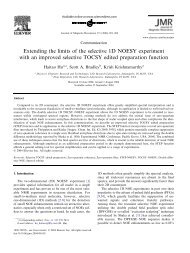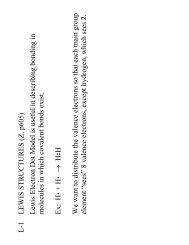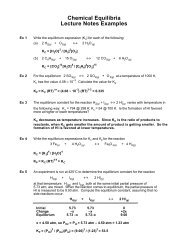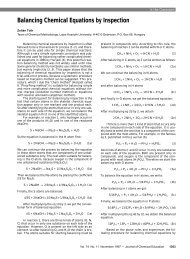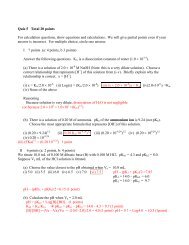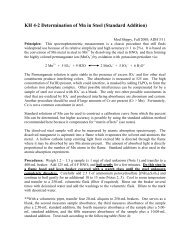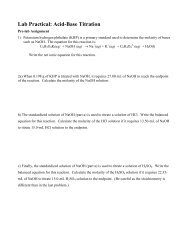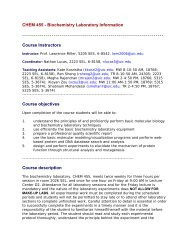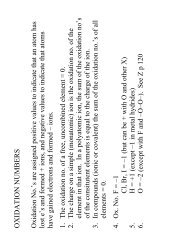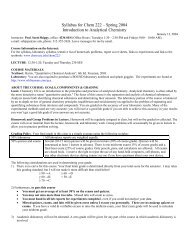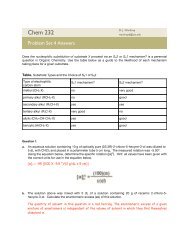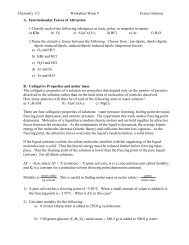Chem 232 Lecture 12 - UIC Department of Chemistry - University of ...
Chem 232 Lecture 12 - UIC Department of Chemistry - University of ...
Chem 232 Lecture 12 - UIC Department of Chemistry - University of ...
- No tags were found...
Create successful ePaper yourself
Turn your PDF publications into a flip-book with our unique Google optimized e-Paper software.
CHEM <strong>232</strong>Organic <strong>Chem</strong>istry I<strong>University</strong> <strong>of</strong> Illinoisat Chicago<strong>UIC</strong><strong>Lecture</strong> <strong>12</strong>Organic <strong>Chem</strong>istry 1Pr<strong>of</strong>essor Duncan WardropFebruary 18, 20101
Self Test QuestionWhich <strong>of</strong> the following reactions proceeds through acarbocation intermediate?AHOHClH Br HBrBrBHBrperoxidesBrBrBrHBrBr+ BrCBrCH 3 ONaCH 3 OHDHBrBrEH 2 , Pd/C<strong>University</strong> <strong>of</strong><strong>UIC</strong>Illinois at ChicagoCHEM <strong>232</strong>, Spring 2010Slide 2<strong>Lecture</strong> <strong>12</strong>: February 182
CHEM <strong>232</strong>Organic <strong>Chem</strong>istry I<strong>University</strong> <strong>of</strong> Illinoisat Chicago<strong>UIC</strong>Hydroboration–OxidationSection 6.<strong>12</strong>-6.143
Addition <strong>of</strong> B-H Bonds to AlkenesC C + X YadditionXC CYC C + H BH 2hydroborationH C C BH 2alkene borane alkyl boraneoxidationoxidation is a separate step and requiresa separate set <strong>of</strong> conditions and reagentsHC COH<strong>University</strong> <strong>of</strong> Illinois<strong>UIC</strong>at Chicago CHEM <strong>232</strong>, Spring 2010alcoholSlide 4<strong>Lecture</strong> <strong>12</strong>: February 184
Boranes - Structure & ElectronicsHHBH• boron is exception to octet rule• sp 2 -hybridized (only 3 valence e - s)• contains an empty p-orbital• strong Lewis acid (electron pair acceptor)• forms 3-bonds (neutral) & 4-bonds (-/ve)“Free” borane (BH 3 ) only exists in gas phase, otherwiseundergoes dimerization to diborane (B 2 H 6 )2 x BH 3dimerizationB 2 H 65<strong>University</strong> <strong>of</strong> Illinoisborane<strong>UIC</strong>at Chicago CHEM <strong>232</strong>, Spring 2010diboraneSlide 5<strong>Lecture</strong> <strong>12</strong>: February 18
Conditions: HydroborationHHBH• boron is exception to octet rule• sp 2 -hybridized (only 3 valence e - s)• contains an empty p-orbital• strong Lewis acid (electron pair acceptor)• forms 3-bonds (neutral) & 4-bonds (-/ve)“Free” borane (BH 3 ) only exists in gas phase, otherwiseundergoes dimerization to diborane (B 2 H 6 )HHBH+HHBHdimerizationHHBHHBHHboranediborane<strong>University</strong> <strong>of</strong> Illinois<strong>UIC</strong>at Chicago CHEM <strong>232</strong>, Spring 2010Slide 6<strong>Lecture</strong> <strong>12</strong>: February 186
Stoichiometry <strong>of</strong> Hydroboration6 xB 2 H 6diglyme2 xB1-butenetributylborane• diglyme is a common solvent• hydroborations typically at room temp.• generally very fast reactionsH 3 C OOO CH 3diglyme: diethylene glycol dimethyl ether<strong>University</strong> <strong>of</strong> Illinois<strong>UIC</strong>at Chicago CHEM <strong>232</strong>, Spring 2010Slide 8<strong>Lecture</strong> <strong>12</strong>: February 188
Lewis Acid-Base ComplexesBorane is a Lewis Acid & Reducing Agent!Other hydroborating reagents with different reactivitiesmay be prepared by adding Lewis bases to diborane (B2H6)B 2 H 6diboraneB 2 H 6diborane++Otetrahydr<strong>of</strong>uran (THF)H 3 C S CH 3dimethyl sulfide (DMS)H 3 BOH 3 B•THFH 3 BCH 3SCH 3H 3 B•DMS}B 2 H 6diborane+Ntriethylamine (TEA)H 3 BN(CH 2 CH 3 ) 3H 3 B•TEA<strong>University</strong> <strong>of</strong> Illinois<strong>UIC</strong>at Chicago CHEM <strong>232</strong>, Spring 2010Slide 9<strong>Lecture</strong> <strong>12</strong>: February 189
Oxidation StephydroborationB 2 H 6diglymeHBH 2 oxidationH 2 O 2NaOH (aq)HOHcarried out in the same reaction vessel(boranes are reactive)• boron is replaced bymore electronegativeatom (O); therefore:oxidation• oxidation usingperoxide (H 2 O 2 ) &hydroxide (OH – ); addedimmediately afterhydroboration• I will not ask you tolearn the mechanismfor this step; for thecurious, see textbookpage 250<strong>University</strong> <strong>of</strong> Illinois<strong>UIC</strong>at Chicago CHEM <strong>232</strong>, Spring 2010Slide 10<strong>Lecture</strong> <strong>12</strong>: February 1810
Hydroboration-Oxidation is Regioselective1. B 2 H 6 , diglyme2. H 2 O 2 , NaOHCH 3 1. H 3 B•S(CH 3 ) 22. H 2 O 2 , NaOH1. H 3 B•THF2. H 2 O 2 , NaOHOHOHCH 3OH• usually written as a twostepprocess• works with diborane (B 2 H 6 )or a borane complex withanother Lewis base• diglyme is a commonsolvent• affords alcohol products;similar to hydration (H2O/H3O + )<strong>University</strong> <strong>of</strong> Illinois<strong>UIC</strong>at Chicago CHEM <strong>232</strong>, Spring 2010Slide 11<strong>Lecture</strong> <strong>12</strong>: February 18Which carbon <strong>of</strong> the alkene becomes bonded to the -OH group? Do you see a pattern here?11
Regioselectivity DeterminedDuring HydroborationO O BH 2O OHcompare to . . .OH 2 SO 4OOSO 3 HH 3 B•THF H 2 O 2 /OH – OH 2 O/heatOH• boron atom is added to least substituted carbonatom, hydrogen atom is added to most substituted• after oxidation, gives the least substituted product• opposite regioselectivity <strong>of</strong> Markovnikov addition<strong>University</strong> <strong>of</strong> Illinois<strong>UIC</strong>at Chicago CHEM <strong>232</strong>, Spring 2010Slide <strong>12</strong><strong>Lecture</strong> <strong>12</strong>: February 18<strong>12</strong>
Mechanism <strong>of</strong> HydroborationH 2 BHCH 3H 2 BHCH 3 CH 3CH 3H 2 BCH 3Why this regioselectivity?H 2 Bnot<strong>University</strong> <strong>of</strong> Illinois• Syn Addition: B and H atoms add to same side(face) <strong>of</strong> C-C double bond at same time• hydride (H:) adds to most substituted carbon• boron adds to least substituted carbon• this is NOT a PROTONATION<strong>UIC</strong>at Chicago CHEM <strong>232</strong>, Spring 2010Slide 13<strong>Lecture</strong> <strong>12</strong>: February 18Note that although the borane generated upon monohydroboration <strong>of</strong> methylcyclopentene is itselftrans-substituted, the hydroboration remains a syn-addition. In other words, it is the BH2 groupand beta-hydrogen on the carbon bearing the methyl group which are in a syn relationship.13
Regioselectivity - 1st RationaleSteric Effects Control Regioselectivity. . .boron is larger than hydrogen; it prefers to add to the less stericallyhindered side <strong>of</strong> the double bond, which is the least substituted side.HBH 2CH 3XHBHHCH 3HHBHHCH HH 2 BHCH 3Steric strain in transitionstate raises Eact for thispathway - slower reaction<strong>University</strong> <strong>of</strong> Illinois<strong>UIC</strong>at Chicago CHEM <strong>232</strong>, Spring 2010Slide 14<strong>Lecture</strong> <strong>12</strong>: February 1814
Regioselectivity - 2nd RationaleElectronic Effects Control Regioselectivity. . .both carbons in alkene develop partial positive charge in transition state; moresubstituted = more partially positively charged = hydride (H:) transfer preferred(faster) to that carbon atom.Lewis acidLewis baseπ-complexπ-complexmost substituted =most partially positively charged =most electrophilic carbon atom =want electrons from a nucleophile mostrearrangedπ-complex<strong>University</strong> <strong>of</strong> Illinois<strong>UIC</strong>at Chicago CHEM <strong>232</strong>, Spring 2010Slide 15<strong>Lecture</strong> <strong>12</strong>: February 1815
Self Test QuestionWhat is the product <strong>of</strong> the following reaction sequence?A.HO1. Br 2 , CH 2 Cl 2 , hv2. NaOC(CH 3 ) 2 , DMSO3. B 2 H 6 , diglyme4. H 2 O 2 , NaOH (aq)?B.C.HOD.HO<strong>University</strong> <strong>of</strong><strong>UIC</strong>Illinois at ChicagoCHEM <strong>232</strong>, Spring 2010E.HOBrSlide<strong>Lecture</strong> <strong>12</strong>: February 1816
CHEM <strong>232</strong>Organic <strong>Chem</strong>istry I<strong>University</strong> <strong>of</strong> Illinoisat Chicago<strong>UIC</strong>Halide Addition to AlkenesSection 6.15-6.1817
Alkene-Halogen AdditionC C + X YadditionXCCYC C + Br Brhalideaddition Br C CBrC C + Cl Clhalideadditionvicinal dibromideCl C C ClC C + I Ivicinal dichloridehalideaddition I C C I<strong>University</strong> <strong>of</strong> Illinois<strong>UIC</strong>at Chicago CHEM <strong>232</strong>, Spring 2010vicinal diiodideSlide 18<strong>Lecture</strong> <strong>12</strong>: February 1818
Typical Reaction Conditionsfor Halogen Addition• only bromine (Br 2 ) and chlorine (Cl 2 ) undergo this reaction• typically use a halogenated solvent like chlor<strong>of</strong>orm (CHCl 3 )• low temperature (0 ºC)• no light (avoid radical halogenation at saturated carbons)<strong>University</strong> <strong>of</strong> Illinois<strong>UIC</strong>at Chicago CHEM <strong>232</strong>, Spring 2010Slide 19<strong>Lecture</strong> <strong>12</strong>: February 1819
Halogenation is Stereospecific• anti addition <strong>of</strong> Br 2 or Cl 2 across double bonds• two halogen atoms are trans to each other in rings<strong>University</strong> <strong>of</strong> Illinois<strong>UIC</strong>at Chicago CHEM <strong>232</strong>, Spring 2010Slide 20<strong>Lecture</strong> <strong>12</strong>: February 1820
Stereospecific Reactions?stereospecificity is the property <strong>of</strong> a reaction mechanism that leads to different stereoisomeric reaction products from different stereoisomeric reactants, or whichoperates on only one (or a subset) <strong>of</strong> the stereoisomers<strong>University</strong> <strong>of</strong> Illinois<strong>UIC</strong>at Chicago CHEM <strong>232</strong>, Spring 2010Slide 21<strong>Lecture</strong> <strong>12</strong>: February 1821
Stereospecific ReactionsStereospecificIn stereospecific reactions, the configuration <strong>of</strong> the product is directly related to theconfiguration <strong>of</strong> the reactant and is determined by the reaction mechanism.Stereoisomeric reactants will give different, stereoisomeric products.CHEM <strong>232</strong> Definition, 2009BrdifferentgeometricalisomersMeMeMeMeBr 2CHCl 3Br 2CHCl 3MeMeBrBrMeBrMestereoisomericproducts resultingfrom anti-halideaddition<strong>University</strong> <strong>of</strong> Illinois<strong>UIC</strong>at Chicago CHEM <strong>232</strong>, Spring 2010Slide 22<strong>Lecture</strong> 10: February 1<strong>12</strong>2
Halogen Addition DoesNot Involve Syn AdditionX• concerted process would require syn addition<strong>of</strong> two halogen atoms• therefore mechanism is not concerted.<strong>University</strong> <strong>of</strong> Illinois<strong>UIC</strong>at Chicago CHEM <strong>232</strong>, Spring 2010Slide 23<strong>Lecture</strong> <strong>12</strong>: February 1823
Halogen Addition DoesNot Involve Free CarbocationsHHCH 2 Br• carbocation intermediate are planar (flat)• addition <strong>of</strong> second halide could approach eitherlobe <strong>of</strong> empty p-orbital on carbocation• therefore this mechanism is not possible becauseit would not be stereoselective<strong>University</strong> <strong>of</strong> Illinois<strong>UIC</strong>at Chicago CHEM <strong>232</strong>, Spring 2010Slide 24<strong>Lecture</strong> <strong>12</strong>: February 1824
Halogen Addition DoesInvolve Halonium IonsH 3 CH 3 CBrHHBrH 3 CH 3 CBrHHBrH 3 CH 3 CBrH 3 CBrH 3 CBrH HHBrH• electron pair in π-bond form new bond to bromine atom asBr-Br bond breaks• lone pair <strong>of</strong> electrons on bromine form new bond to alkenecarbon losing a bond at the same time (concerted)• halonium ions (three-membered rings with one halogen) areintermediates; no carbocation intermediates<strong>University</strong> <strong>of</strong> Illinois<strong>UIC</strong>at Chicago CHEM <strong>232</strong>, Spring 2010Slide 25<strong>Lecture</strong> <strong>12</strong>: February 1825
Anti Addition..–: Br:....Br..:..Br..:attack <strong>of</strong> bromide (Br – ) fromopposite side C-Br bond thatis breaking gives anti product..:<strong>University</strong> <strong>of</strong> Illinois<strong>UIC</strong>at Chicago CHEM <strong>232</strong>, Spring 2010Slide 26<strong>Lecture</strong> <strong>12</strong>: February 1826
Hyperconjugation (σ C-H →π C=C )Increases Rate <strong>of</strong> HalogenationHC C C HHσ➞∏donationalkeneH HH HH 3 C HH HH 3 C HH 3 C HH 3 C CH 3H 3 C CH 3relative rate (krel)1615400920,000• more alkyl groups attached to double bond ➡• more σ➞π orbital donation/overlap ➡• double bond has more electron density ➡• double bond is a stronger nucleophile (Lewis base) ➡• reacts faster with electrophiles like Br-Br<strong>University</strong> <strong>of</strong> Illinois<strong>UIC</strong>at Chicago CHEM <strong>232</strong>, Spring 2010Slide 27<strong>Lecture</strong> <strong>12</strong>: February 1827
Halogen Addition Modification:Aqueous Solutions Give Halohydrinsbromohydrin• if the solvent for the reaction is changed to water,halohydrins are formed• since water is much more concentrated, it will add tohalonium ion intermediate faster than the halide<strong>University</strong> <strong>of</strong> Illinois<strong>UIC</strong>at Chicago CHEM <strong>232</strong>, Spring 2010Slide 28<strong>Lecture</strong> <strong>12</strong>: February 1828
Ring Opening <strong>of</strong>Halonium Ions is RegioselectiveH 3 CH 3 CBrHHBrH 3 CH 3 CBrHHBrOH 2H 3 CH 3 CHOHBrH HOH 2H 3 CH 3 CHOH 3 CHH 3 CBrH HHBrH• product is most substituted alcohol;least substituted halide• most substituted carbon is mostpartially positively charged intransition state = strongestelectrophile = water most attractedto that carbon<strong>University</strong> <strong>of</strong> Illinois<strong>UIC</strong>at Chicago CHEM <strong>232</strong>, Spring 2010Slide 29<strong>Lecture</strong> <strong>12</strong>: February 1829
CHEM <strong>232</strong>Organic <strong>Chem</strong>istry I<strong>University</strong> <strong>of</strong> Illinoisat Chicago<strong>UIC</strong>Epoxidation& OzonolysisSections 6.19We will skip epoxide nomenclature for now.30
Expoxides (a.k.a Alkene oxides)• three-membered rings containing an oxygen atom• common intermediates in organic synthesis<strong>University</strong> <strong>of</strong> Illinois<strong>UIC</strong>at Chicago CHEM <strong>232</strong>, Spring 2010Slide 31<strong>Lecture</strong> <strong>12</strong>: February 1831
Epoxides are Preparedvia Alkene EpoxidationOH 3 C OHacetic acidOOH 3 C O Hperoxyacetic acid• peroxyacids are source <strong>of</strong> electrophilic oxygen atoms• addition <strong>of</strong> a single oxygen atom across double bond• similar to formation <strong>of</strong> bromonium ion intermediate• don’t worry about mechanism; for curious see textbook page 257<strong>University</strong> <strong>of</strong> Illinois<strong>UIC</strong>at Chicago CHEM <strong>232</strong>, Spring 2010Slide 32<strong>Lecture</strong> <strong>12</strong>: February 1832
Examples• any peroxyacid will work• more substituted double bonds react faster• because only adding one atom across double bond, must be syn addition<strong>University</strong> <strong>of</strong> Illinois<strong>UIC</strong>at Chicago CHEM <strong>232</strong>, Spring 2010Slide 33<strong>Lecture</strong> <strong>12</strong>: February 1833
Alkenes are Cleaved via OzonolysisozoneO O OR 1 R 3R 2CCR 4synadditionOOOR 1 C C R 3R 2 R 4Alkene Primary (1°)ozonideR 1 O R 3C CR 2 O O• ozone adds across double bonds to give ozonides• ozonides react further with reducing agents to providecarbonyl compounds• we will not discuss mechanism for this reactionR 4Secondary (2°)ozonidereductionOR 1 R 2OR 2 R 3Carbonylcompounds<strong>University</strong> <strong>of</strong> Illinois<strong>UIC</strong>at Chicago CHEM <strong>232</strong>, Spring 2010Slide 34<strong>Lecture</strong> <strong>12</strong>: February 1834
Ozonolyis is a Two Step Processreducing agents;reduce ozonide intermediatepattern = alkene is cut in half and replaced by an oxygenatom at each endcarbonyl product depends on substitution <strong>of</strong> alkene<strong>University</strong> <strong>of</strong> Illinois<strong>UIC</strong>at Chicago CHEM <strong>232</strong>, Spring 2010Slide 35<strong>Lecture</strong> <strong>12</strong>: February 1835
CHEM <strong>232</strong>Organic <strong>Chem</strong>istry I<strong>University</strong> <strong>of</strong> Illinoisat Chicago<strong>UIC</strong>Organic SynthesisSection 6.21We will not cover section 6.22.36
Retrosynthetic AnalysisHow could you prepare 1-methylcyclohexene frommethylcyclohexane?CH 3?CH 3Step One: Devise a retrosynthesis. Work backwards from the targetmolecule. Each step backward you should ask, How can I prepare thetarget functional group.CH 3 CH 3BrCH 337dehydrohalogenationradical bromination<strong>University</strong> <strong>of</strong> Illinois<strong>UIC</strong>at Chicago CHEM <strong>232</strong>, Spring 2010Slide 37<strong>Lecture</strong> <strong>12</strong>: February 18
Synthetic RouteHow could you prepare 1-methylcyclohexene frommethylcyclohexane?CH 3?CH 3Step One: Write the synthesis out in the forward direction includingall necessary reagents and conditions.CH 3 Br 2 , CHCl 3light, 60 ºCCH 3BrNaOCH 2 CH 3DMSO, 55 ºCCH 338<strong>University</strong> <strong>of</strong> Illinois<strong>UIC</strong>at Chicago CHEM <strong>232</strong>, Spring 2010Slide 38<strong>Lecture</strong> <strong>12</strong>: February 18
Self Test QuestionWhich retrosynthetic analysis is correct for thesynthesis <strong>of</strong> 2-bromocyclopentanol?A.BrOHBrOHBr 2 , CHCl 3light, 60 ºCBrB.BrOHBrNaOCH 2 CH 3DMSO, 55 ºCBr 2H 2 O/THFBrOHC.BrOHOHD.BrOHOH<strong>University</strong> <strong>of</strong><strong>UIC</strong>Illinois at ChicagoCHEM <strong>232</strong>, Spring 2010Slide 39<strong>Lecture</strong> <strong>12</strong>: February 1839
Self Test QuestionDevise a retrosynthesis for the synthetic targetbelow.HClClA.?ClB.ClCl1. B 2 H 6 , diglyme2. H 2 O 2 , NaOHSOCl 2K 2 CO 3C.ClOHOHD.ClO<strong>University</strong> <strong>of</strong><strong>UIC</strong>Illinois at ChicagoCHEM <strong>232</strong>, Spring 2010Slide 40<strong>Lecture</strong> <strong>12</strong>: February 1840
Self Test QuestionWhat is the product <strong>of</strong> the following series <strong>of</strong> reactions?A.OOOH1. Pt/C, H 2 (g), CH 3 CH 2 OH2. H 2 SO 4 (conc.)3. H 2 O, heat4. peroxyacetic acidOB.OSO 3 HOHC.OSO 3 HD.O<strong>University</strong> <strong>of</strong><strong>UIC</strong>Illinois at ChicagoCHEM <strong>232</strong>, Spring 2010Slide 41<strong>Lecture</strong> <strong>12</strong>: February 1841
Self Test QuestionWhich starting material could be used to prepare themolecule below? Write out your synthesis. Don’t guess.HOHA.D.BrOB.OOE.C.HH<strong>University</strong> <strong>of</strong><strong>UIC</strong>Illinois at ChicagoCHEM <strong>232</strong>, Spring 2010Slide 42<strong>Lecture</strong> <strong>12</strong>: February 1842
CHEM <strong>232</strong>Organic <strong>Chem</strong>istry I<strong>University</strong> <strong>of</strong> Illinoisat Chicago<strong>UIC</strong>Next <strong>Lecture</strong>. . .Chapter 13: Sections 13.1-13.2 & 13.20-13.2243
Quiz & Exam AveragesQuiz 1 = 61%Quiz 2 = 61%Quiz 3 = 50%Quiz 4 = 50%Midterm Exam = 51%<strong>University</strong> <strong>of</strong><strong>UIC</strong>Illinois at ChicagoCHEM <strong>232</strong>, Spring 2010Slide 44<strong>Lecture</strong> <strong>12</strong>: February 1844



